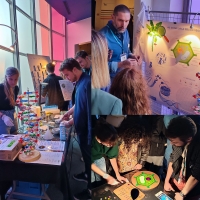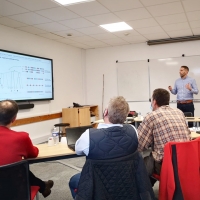Newsletter 2023
In 2023, the CNRGV continues to develop its know-how and its service offer, divided into three major areas:
- Supporting plant genomics projects with services such as the extraction of high molecular weight DNA and the cloning of large DNA fragments.
- Providing high-quality reference genomes, by taking charge of the entire process, from DNA extraction to sequence assembly and annotation. This work is done together with sequencing platforms offering "long-reads" technologies. We enhance value of sequence data by combining with optical mapping and DNA conformation analysis approaches to achieve T2T genome assemblies.
- Offering a range of strategies to explore the intraspecific diversity of regions of interest. These strategies are based on the pull-CATCH method and on the Samplix technology.
If one of these services meets your needs or raises your curiosity, please contact us. We would be happy to talk to you about it.
2022 in brief
|
| Optical maps
The CNRGV has produced more than 300 optical genome maps since 2016, including 61 in 2022. Unique in its principle, it is an unvaluable tool for the improvement of genome assembly. |
|
| High quality genome assembly
The CNRGV has assembled 54 plant genomes in 2022. We improved our process developing alternative DNA extraction and purification protocols to cover any plant species, and implementing Omni-C library preparation and data analysis. |
|
| Projects
92 projects have been completed for 60 collaboration partners. We are grateful for their confidence. |
|
| Publications
Expanding duplication of the testis PHD Finger Protein 7 (PHF7) gene in the chicken genome. Genomics. 2022 Jul;114(4):110411. Capturing Wheat Phenotypes at the Genome Level. Front. Plant Sci. 13:851079. Intact ribosomal DNA arrays of Potentilla origin detected in Erythronium nucleus suggest recent eudicot-to-monocot horizontal transfer. New Phytol. 2022 Aug;235(3):1246-1259. A chromosome-level, haplotype-phased Vanilla planifolia genome highlights the challenge of partial endoreplication for accurate whole-genome assembly. Plant Communications. Long-read and chromosome-scale assembly of the hexaploid wheat genome achieves higher resolution for research and breeding. BioRxiv, 1–29. The haplotype-resolved chromosome pairs of a heterozygous diploid African cassava cultivar reveal novel pan-genome and allele-specific transcriptome features. GigaScience, 11, 1–21. Cantaloupe melon genome reveals 3D chromatin features and structural relationship with the ancestral Cucurbitaceae karyotype. IScience, 103696. Long-read genome sequencing of bread wheat facilitates disease resistance gene cloning. Nature Genetics, 54(3), 227–231.
|
|
| Contract extensions
Charlotte Cravero (bioinformatics) and Robin Schwartz (wetlab) have their fixed-term contracts extended in 2023 to maintain service activity. |
|
| |
|
| End of contracts
Nicolas Théron and Margaux-Alison Fustier completed their engineer fixed-term contract. Both have contributed greatly to the development of our new bioinformatic services by engaging in analysis pipeline development.Thank you both for your inputs and contributions. |
Highlights
| | Public communication
|
| | Sustainable development policy
|
| | Accomplishment
|









